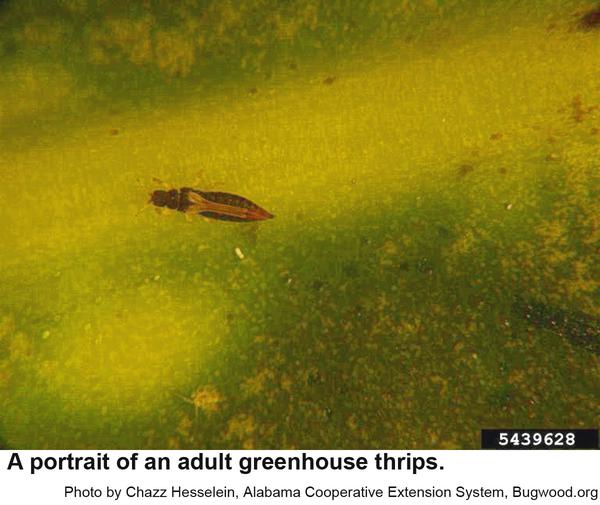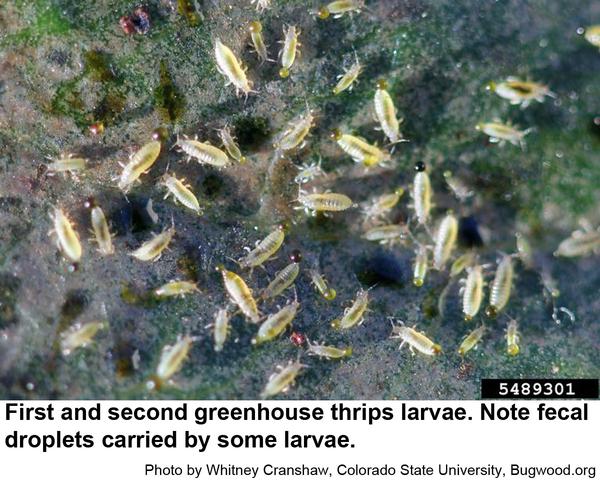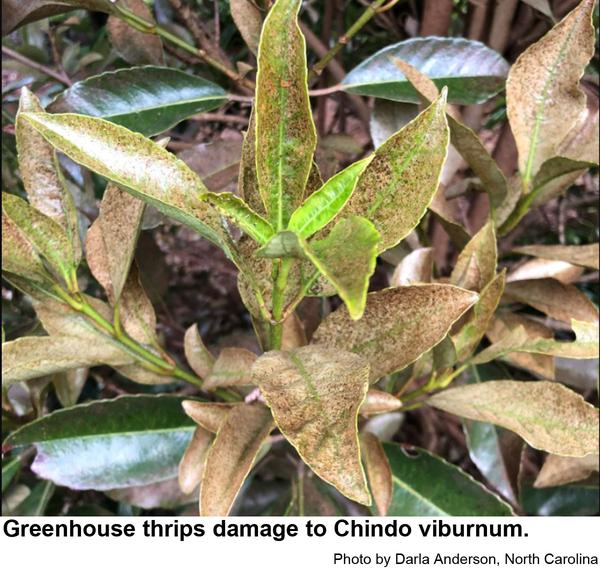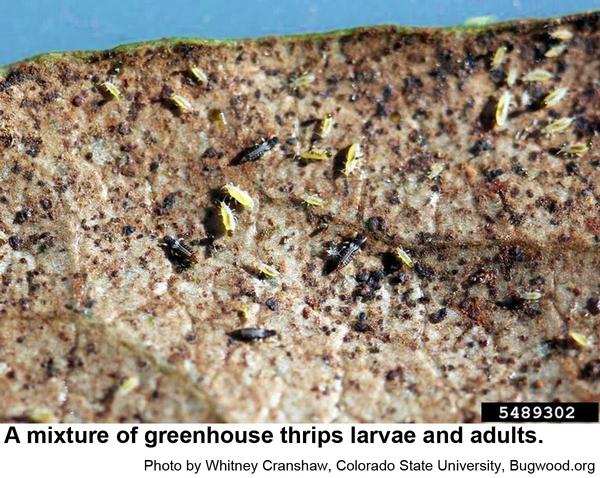Description and Biology
The greenhouse thrips, Heliothrips haemorrhoidalis, is dark brown with the tail end much lighter. The legs tend to be uniformly yellow, and the wings are paler and narrow. The antennae are slender with a characteristic needle-like tip. The mature adults are about 1/16 inch long. Females insert very small, white, banana-shaped eggs into leaves. From eggs hatch tiny, white larvae. The next larval stage is yellowish. Both stages have red eyes and often carry a dark fecal droplet at the tip of the abdomen. Second larvae molt into prepupae that soon molt into pupae. These stages are yellowish with red eyes and do not move about freely. Pupae have longer wing pads, and the antennae bend back over body. Pupae darken with age. Unlike other species of thrips whose prepupae and pupae drop to the soil, at least some greenhouse thrips pupae remain on infested leaves. Each female inserts 25 to 50 eggs in leaves. Under optimum conditions the time for development is 17 to 20 days for the eggs, about 13 days for the two larval instars, and about 5 days for the prepupal and pupal stages. The adults can live 7 weeks on plants growing in the greenhouse. All stages can be found throughout the year in greenhouses. Greenhouse thrips move relatively slowly and rarely fly. They prefer a cool, shady, and fairly moist atmosphere.
Host Plants
Greenhouse thrips attack over 100 hosts, principally greenhouse and ornamental plants, but also a few crops and tropical plants. Some of the hosts are azalea, begonia, croton, cyclamen, ferns, fuchsia, grape vines, orchids, palm, rose, and viburnum. This thrips feeds almost entirely on the foliage, and large populations cause severe damage. Greenhouse thrips usually injure inner leaves, neither the youngest nor the oldest, and fruit. Damaged leaves appear silvery or bleached and, if the damage is severe enough, turn yellow and drop. Fruit that has been attached is brown, cracked, and has noticeable sunken areas. Dark spots of excrement are often noticeable on the leaves and fruit.
Residential Recommendations
Two predators are relatively effective for the biological control of thrips: Orius insidiosus (the insidious plant bug) and Neoseiulus cucumeris (a predaceous mite). These beneficial arthropods are available from biological control suppliers. Because thrips insert their eggs into their host plant, a contact insecticide may kill all the exposed thrips but may not kill their eggs. Depending upon the insecticide, thrips eggs hatch into new, tiny thrips as long as two weeks after treatment so the infestation may have a second wave. Insecticides such as horticultural oils, soaps, pyrethrin and perhaps neem extracts have little residual life after they are sprayed onto a plant, so repeated applications at two week intervals might be necessary for complete control. Orthene and imidacloprid are two systemic insecticides that would last in the plant long enough to kill any newly-hatched larvae that as eggs escaped the first application. Several formulations of imidacloprid are available for residential landscape use (The active ingredient of any pesticide is listed on the front label although usually in very small font close to the bottom.). Pyrethroids are in a third group of insecticides useful for thrips suppression. When used as directed, pyrethroids are very toxic to insects but are not particularly hazardous to humans and pets (other than fish—avoid using pyrethroids around pools, ponds, and streams). They have a long residual life on the plant after application and would last long enough to suppress newly-hatched thrips larvae. The active ingredient of all pyrethroid insecticides end in "thrin" such as bifenthrin, lamda-cyhalothrin, or permethrin. All of these insecticides listed above can be purchased at big box stores, nurseries, and plant centers.
Other Resources
- Common name: greenhouse thrips, scientific name: Heliothrips haemorrhoidalis (Bouché) (Insecta: Thysanoptera: Thripidae). Denmark, H. A. and T.R. Fasulo. 2019 (reviewed). Featured Creatures, Entomology & Nematology, FDACS/DPI, EDIS Publication Number: EENY-75.
- Greenhouse thrips - Heliothrips haemorrhoidalis. martin, N. A. 2018 (revised). Interesting Insects & other Invertebrates. New Zealand Arthropod Factsheet Series No. 105.
- Insect and Related Pests of Flowers and Foliage Plants. Baker, J. R. ed. 1994 (revised). NC Cooperative Extension Service pub. AG-136.
- Extension Plant Pathology Publications and Factsheets
- Horticultural Science Publications
- North Carolina Agricultural Chemicals Manual
For assistance with a specific problem, contact your local Cooperative Extension Center.
This Factsheet has not been peer reviewed.
Publication date: June 5, 2020
Revised: June 5, 2020
Recommendations for the use of agricultural chemicals are included in this publication as a convenience to the reader. The use of brand names and any mention or listing of commercial products or services in this publication does not imply endorsement by NC State University or N.C. A&T State University nor discrimination against similar products or services not mentioned. Individuals who use agricultural chemicals are responsible for ensuring that the intended use complies with current regulations and conforms to the product label. Be sure to obtain current information about usage regulations and examine a current product label before applying any chemical. For assistance, contact your local N.C. Cooperative Extension county center.
N.C. Cooperative Extension prohibits discrimination and harassment regardless of age, color, disability, family and marital status, gender identity, national origin, political beliefs, race, religion, sex (including pregnancy), sexual orientation and veteran status.




